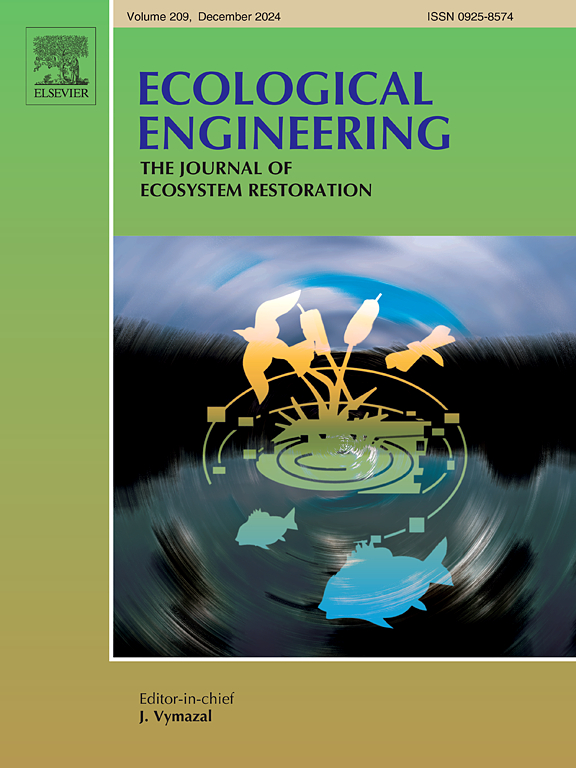亚热带城市河流恢复对底栖大型无脊椎动物恢复的响应及影响因素
IF 4.1
2区 环境科学与生态学
Q1 ECOLOGY
引用次数: 0
摘要
世界上许多地区的城市河流都受到水环境和生态退化的影响,传统的修复策略的效果仍然不确定。本研究通过分析底栖大型无脊椎动物群落和水质的响应,评价了城市河流修复后的初步生态恢复情况。采用生物完整性指数(IBI)对硬堤工程的影响进行了量化,该指数由5个核心指标组成:类群数、Shannon-Wiener指数、Tubificidae%、耐受性%和收集者%。数据采集于广州市11条经处理的城市河道的29个采样点。随着不透水面面积的增加,敏感物种减少或消失,而寡毛纲和Chironomidae等耐污染物种成为优势物种。大型无脊椎动物多样性和功能摄食组显著减少,导致“非常差”和“差”的健康状况。影响底栖生物物种多样性的关键水体参数包括溶解氧(DO)、化学需氧量(CODMn)、总磷(TP)、深度和流速。大型无脊椎动物的Shannon-Weiner指数和功能摄食组在干扰区表现出季节性一致性(P <;0.05)。然而,底栖生物完整性指数(B-IBI)评价结果存在季节性差异,与干扰强度显著相关,表明底栖生物群落对生境压力的敏感性。补水策略缓解了早期城市化的影响,突出了其在提高城市河流恢复力方面的作用,并为生态恢复和全球城市河流管理提供了新的见解。本文章由计算机程序翻译,如有差异,请以英文原文为准。

Responses and influencing factors of benthic macroinvertebrate recovery in restored subtropical urban rivers
Urban streams in many regions of the world are subject to water environment and ecological degradation, and the efficacy of conventional remediation strategies remains uncertain. This study evaluated the initial ecological recovery in rehabilitated urban streams by analyzing the response of benthic macroinvertebrates community and water quality. The effects of hard embankment engineering were quantified using an Index of Biological Integrity (IBI), which was derived from five core indicators: number of taxa, Shannon-Wiener index, Tubificidae%, tolerant% and collectors%. Data were collected from 29 sampling sites across 11 treated urban channels in Guangzhou City. As impervious surface area increased, sensitive species declined or vanished, while pollution-tolerant species like Oligochaeta and Chironomidae became dominant. Macroinvertebrate diversity and functional feeding groups significantly decreased, leading to “very poor” and “poor” health statuses. Key water parameters affecting benthic species diversity included dissolved oxygen (DO), chemical oxygen demand (CODMn), total phosphorus (TP), depth, and flow velocity. The Shannon-Weiner index and functional feeding group for macroinvertebrates show seasonal consistency in disturbance zones (P < 0.05). However, Benthic Index of Biological Integrity (B-IBI) assessment results vary seasonally, correlating significantly with disturbance intensity, indicating benthic communities' sensitivity to habitat stressors. Water replenishment strategies mitigate early urbanization impacts, highlighting their role in boosting urban stream resilience and offering new insights for ecological rehabilitation and global urban river management.
求助全文
通过发布文献求助,成功后即可免费获取论文全文。
去求助
来源期刊

Ecological Engineering
环境科学-工程:环境
CiteScore
8.00
自引率
5.30%
发文量
293
审稿时长
57 days
期刊介绍:
Ecological engineering has been defined as the design of ecosystems for the mutual benefit of humans and nature. The journal is meant for ecologists who, because of their research interests or occupation, are involved in designing, monitoring, or restoring ecosystems, and can serve as a bridge between ecologists and engineers.
Specific topics covered in the journal include: habitat reconstruction; ecotechnology; synthetic ecology; bioengineering; restoration ecology; ecology conservation; ecosystem rehabilitation; stream and river restoration; reclamation ecology; non-renewable resource conservation. Descriptions of specific applications of ecological engineering are acceptable only when situated within context of adding novelty to current research and emphasizing ecosystem restoration. We do not accept purely descriptive reports on ecosystem structures (such as vegetation surveys), purely physical assessment of materials that can be used for ecological restoration, small-model studies carried out in the laboratory or greenhouse with artificial (waste)water or crop studies, or case studies on conventional wastewater treatment and eutrophication that do not offer an ecosystem restoration approach within the paper.
 求助内容:
求助内容: 应助结果提醒方式:
应助结果提醒方式:


